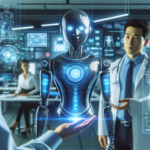
Table of Contents
Introduction
In the ever-evolving landscape of technology, the era of automatons has dawned, bringing forth a wave of transformative change. This article delves into the expansive world of robotics, exploring its foundations, applications across industries, challenges, and the ethical considerations surrounding the rise of machines in 2024.
At its core, robotics is a multidisciplinary field that encompasses the design, creation, programming, and operation of robots. These robots are intelligent machines designed to perform tasks autonomously or semi-autonomously, often with the aim of assisting or replacing human activities. Robotics draws from various branches of engineering, computer science, and other scientific disciplines to develop machines that can perceive their environment, make decisions, and execute actions.
The term “robot” itself originated from the Czech word “robota,” meaning forced labor or drudgery. However, in the modern context, robots are not confined to labor-intensive roles but span a wide range of applications across different industries.
Key components of robotics include:
- Mechanical Structure: The physical form of a robot, including its limbs, actuators, and sensors. This structure is designed based on the tasks the robot is intended to perform.
- Power Source: Robots require a power source to operate, whether it’s electrical, hydraulic, or pneumatic. The choice depends on the application and the robot’s design.
- Actuators: These are the mechanisms responsible for the robot’s movement. They can include motors, hydraulics, or other systems that enable the robot to perform tasks like lifting, gripping, or moving.
- Sensors: Sensors provide robots with the ability to perceive their environment. This can include cameras, infrared sensors, touch sensors, and more, depending on the specific functionalities required.
- Control Systems: The brains of the operation, control systems dictate how the robot processes information from sensors and executes actions. This often involves sophisticated algorithms and programming.
- Programming: Robots are typically programmed to perform specific tasks. This programming can range from simple commands for basic robots to complex algorithms for more advanced systems.
- Artificial Intelligence (AI): AI plays a crucial role in modern robotics, enabling robots to learn from experience, adapt to changing conditions, and make decisions based on their environment.
- Human-Robot Interaction: As robots become more prevalent, the field also explores ways to facilitate smooth interaction between humans and robots. This involves designing robots that can understand human input and communicate effectively.
Robotics has applications in various sectors, including manufacturing, healthcare, agriculture, space exploration, and more. It continues to evolve rapidly, with ongoing research and development pushing the boundaries of what robots can achieve, making them an integral part of our technologically advancing world.
Foundations of Robotics in 2024
As we step into 2024, robotics stands on the shoulders of remarkable advancements in hardware and sensors. The integration of Artificial Intelligence (AI) has propelled robots beyond mere automation, enabling them to perceive, learn, and adapt to dynamic environments.
Robotics in Various Industries
The impact of robotics is felt across diverse sectors. In healthcare, robots are revolutionizing surgery and patient care. In manufacturing, automation is reshaping production lines, and in service industries, robots are taking on roles in hospitality and customer service.
Challenges and Innovations in Robotic Design
Despite progress, challenges persist in the field of robotics, from limitations in mobility to the intricate design of robotic appendages. Bio-inspired design is unlocking new possibilities by mimicking nature to enhance the functionality of robotic systems.
Collaborative Robotics: Humans and Machines Working Together
Collaborative robots, or cobots, are redefining the workplace. These machines work alongside humans, enhancing efficiency and safety. The collaborative approach ensures a harmonious coexistence between human workers and their robotic counterparts.
The Role of AI in Robotic Decision-Making
The integration of machine learning algorithms empowers robots to make informed decisions. However, ethical considerations loom large, particularly in the realm of autonomous robotics. Striking a balance between innovation and responsible AI usage is crucial.
Robotics and the Future of Work
As robots become more prevalent in various industries, questions arise about their impact on employment. The article explores how the workforce is adapting, reskilling, and preparing for a future where robots are integral to daily operations.
Robotic Trends in 2024
Emerging technologies, such as 5G and the Internet of Things (IoT), are influencing the trajectory of robotics. The article investigates the latest trends shaping the landscape, from advanced sensors to interconnected robotic systems.
Consumer Robotics: Beyond Sci-Fi
Robots are no longer confined to science fiction; they are becoming an integral part of daily life. From smart homes to personal assistants, consumer robotics is affordable and accessible, ushering in a new era of convenience.
Robo-Ethics: Navigating Moral and Legal Frameworks
As robots become ubiquitous, establishing ethical guidelines and legal frameworks is imperative. The article delves into the ethical considerations surrounding robotics and the responsibilities borne by developers and users alike.
Green Robotics: Sustainability in Automation
Environmental sustainability takes center stage in the discussion on robotic manufacturing. The article explores how the industry is adopting eco-friendly practices, ensuring that the automation wave does not compromise the planet’s well-being.
The Hurdles of Humanoid Robotics
Creating humanoid robots that mimic human movements and interactions is both a marvel and a challenge. Ethical considerations arise in the quest for human-like robots, prompting a reflection on the role of these machines in society.
Innovations in Robotic Learning and Adaptation
Robots are evolving from static programmed machines to adaptive learners. The article investigates how continuous learning capabilities allow robots to navigate dynamic environments and perform a variety of tasks.
Educational Initiatives in Robotics
Fostering interest in robotics begins with education. From school-level programs to university courses, the article explores initiatives aimed at cultivating STEM skills and preparing the next generation for a future intertwined with robotics.
Conclusion
As we navigate the robotics landscape in 2024, it is evident that we stand at the threshold of a new era. From collaborative workplaces to eco-conscious manufacturing, robots are shaping our world. Embracing this transformative wave while addressing ethical considerations is key to harnessing the full potential of the era of automatons.
Frequently Asked Questions
- How are robots being used in healthcare in 2024?
- In 2024, robots will play a vital role in healthcare, assisting in surgeries, patient care, and even tasks like medication dispensing.
- What is the difference between automation and robotics in manufacturing?
- Automation focuses on repetitive tasks, while robotics in manufacturing involves the use of intelligent machines that can adapt to different tasks and environments.
- Are robots taking away jobs?
- While robots are automating certain tasks, they also create new job opportunities in the fields of robotics, maintenance, and programming.
- How can individuals prepare for a career in robotics?
- Pursuing education in STEM fields and gaining hands-on experience with robotics through internships and projects are effective ways to










yandanxvurulmus.wYBRdMmyK8Ab